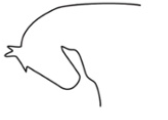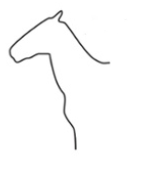Protect your pets: Common toxic plants to avoid
How to identify toxic plants and recognise signs of pet poisoning.
Read more6 August 2018
Equine welfare has featured prominently in the agendas of equestrian racing clubs and councils in recent years. The International Federation for Equestrian Sports (FEI) Code of Conduct implies that the ‘welfare of the horse must be paramount’ which includes not subjecting a horse to training methods which cause harm and monitoring injuries sustained in competition[1]. So the responsibility of a horse trainer is to adopt training techniques that will encourage a HNP that optimises the horse’s riding performance while minimising any short or long-term damage to their overall health.
Hyperflexion (behind the vertical)
Hyperflexion, where the horse’s neck is elongated and sits in an extreme low position with the bridge of the noise behind the vertical (fig 1) is commonly witnessed in modern-day competitive dressage (the “rollkur” method). A study conducted by Dutch scientists[2] revealed that a hyperflexed HNP caused the highest increase in pressure in the trachea, restricting air flow. This is not good news for horse riders aspiring towards trophy wins as the faster the horse goes, the greater the air pressure in the trachea which causes the horse to work harder and tire more quickly. And from a welfare perspective, horses ridden in rollkur display more signs of discomfort, such as tail-swishing and ears fixed back, then horses ridden in a more natural poll flexion with the bridge of the nose slightly in front of the vertical.

Fig 1. Hyperflexion (behind the vertical)
Extremely elevated head (in front of the vertical)
This is where the head sits in an artificially high position with the bridge of the noise in front of the vertical (fig. 2). A study conducted at the University of Zurich[3] found that both extension of the neck (such as in hyperflexion) and shortening of the neck (such as in the elevated head position) shifted the horse’s natural weight distribution. This not only affects their balance but inevitably leads to strain in the muscles of the back and stiffness in movement, thus restricting the horse’s performance.

Fig 2. Elevated head (in front of the vertical)
A HNP that eliminates muscle tension and allows natural and free range of motion is the best scenario for racing horses. However, because all horses have a unique anatomy that changes with age, activity level and training style it is not possible to recommend a standard HNP that is ideal for all horses. However, research does suggest that artificial HNPs that sit significantly behind or in front of the vertical (as depicted in fig 1 and 2) are likely to place the most strain on a horse’s neck.
Certain riding styles and techniques cause improper HNPs to develop, particularly the popular “rolkur” method which has been practised as early as the 17th century. Luckily equitation science is a growing field, ushering in a new body of research into the training of horses with the aim of identifying and improving techniques that are ineffective or cause suffering. The International Society for Equitation Science is one such not-for-profit organisation that educates current and aspiring riders on training styles that don’t compromise a horse’s welfare. Equine veterinarians can assess riding horses for signs of neck or back pain. A good vet will conduct detailed exams including testing the horse’s neck flexibility, palpitating the neck and back to identify sights of pain or discomfort, conducting full lameness and neurological exams and diagnostic imaging such as bone scans and radiography. They will also look out for clinical signs of neck or back pain such as arthritis and impingement of the joints and offer corrective treatments which can include acupuncture, non-steroidal anti-inflammatory drugs (NSAIDs), injections, chiropractics and laser therapy.
Competitive horse riding should not compromise the physical and psychological wellbeing of the horse. Thanks to research we can now identify non-natural HNPs that negatively impact a horse’s performance and health and improve riding techniques that cause or exacerbate the issue.
[1] Federation Equestre Internationale, FEI Code of Conduct for the Welfare of the Horse, 1 Jan, 2013, https://inside.fei.org/fei/your-role/veterinarians/welfare
[2] Leste-Lasserre, Christa, ”Artificial Head, Neck Positions Effects on Horses’ Breathing”, The Horse, 21 Jun, 2012, https://thehorse.com/117618/artificial-head-neck-positions-effects-on-horses-breathing/
[3] Kentucky Equine Research Staff, “Equine Head/Neck Position Influences Balance”, Equinews, 28 Mar, 2011, https://ker.com/equinews/head-neck-position-influences-balance-and-stride/
Petcover specialises in offering quality, straightforward pet insurance with a range of policy options that suit your needs. Whether your pet is big or small, furry or scaly our range of cover options are packed with added benefits. Accidents can happen at any time and the reality of veterinary costs can come a quite a shock. With our range of cover levels for dogs, cats, horses and exotic animals, why not get a quote today.
Get a quote